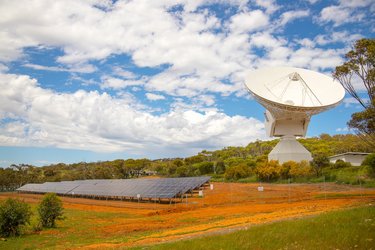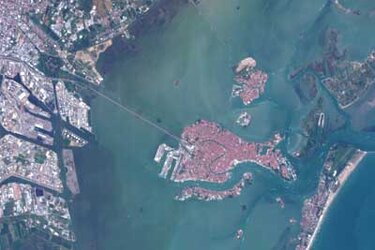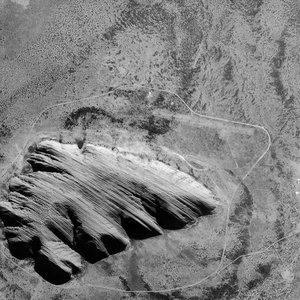Proba workshop: small satellite yielding beautiful results
In orbit for three and a half years now, ESA's smallest Earth Observation satellite is making a big contribution to science, a workshop heard this week. Proba applications range from studying land vegetation to water quality monitoring, assessing productivity of Italian vineyards, even helping hunt for meteorite impact craters.
ESA's Proba microsatellite is about the same size and shape as a washing machine. It was launched on 22 October 2001 as a one-year technology demonstrator, but continuing high in-orbit performance has led to it being adopted as an Earth Observation Third Party Mission.
Proba's largest instrument is the Compact High Resolution Imaging Spectrometer (CHRIS), a hyperspectral imager that can view the Earth's surface to a spatial resolution of 18 metres in a combination of up to 19 out of 62 programmable spectral bands to return highly detailed environmental information.
Some 56 scientific teams worldwide are either currently using or planning to use CHRIS data. This week saw the Third Proba/CHRIS Workshop take place at ESRIN in Frascati, ESA's establishment in Italy. Starting on 21 March, the three-day event was an opportunity for researchers to share current results and future plans, and have an input into future CHRIS acquisition planning.

"What this workshop makes clear is that CHRIS/Proba is no longer a technology demonstrator but has become a real tool for actual research and applications," stated Professor Jose Moreno of the University of Valencia.
One leading application for CHRIS – both by itself or in combination with other satellite sensors – is the study of land vegetation and forests. The imager's combination of high resolution and wide spectral range means that a large amount of important biophysical and biochemical properties can be gathered, including chlorophyll and water content, leaf area index and overall biomass and health.
CHRIS has another advantage in this area, as Moreno explained: "The really unique capability of the instrument is being able to provide multi-angular views of the same site".

CHRIS can acquire up to five images of a desired target at a time. Meanwhile the entire satellite is able to perform a continuous roll, so that the target is acquired at different angles, especially useful when trying to assess vegetation or woodland canopy structure and density and differentiate individual plant or tree species.
Heike Bach of the German company VISTA GmbH explained how CHRIS images of agricultural crops were being used to estimate crop type and state. Meanwhile Anne Bourguignon of the French geosciences organisation BRGM is utilising CHRIS to study water run-off and soil erosion from crops at sites in Toulouse and Strasbourg.
The workshop also heard how CHRIS images are being used to help study the state of woodland in the Rhineland Palatine in Germany and measure the carbon flux of Harwood Forest in Northumbria in the UK, to study the role of woodland as both sinks and sources of carbon dioxide, the single most important greenhouse gas.

A German team from the Universities of Kaiserslautern and Würzburg plans to use CHRIS imagery to study an often-overlooked zone of life in South African and Namibian deserts. They are interested in studying changes in soil reflectance caused by Biological Soil Crusts (BSCs), communities of organisms and their by-products found at the surface of desert soils not occupied by vegetation.
CHRIS is also playing a part within ESA's TIGER Initiative, intended to apply Earth Observation to the integrated management of developing nation water resources, with a particular focus on Africa.
The University of the Western Cape in South Africa wants to use CHRIS imagery to differentiate stressed and non-stressed tree stands in the vicinity of Johannesburg gold mines, to evaluate the possibility of planting trees to absorb water polluted by heavy metal waste from the mine, in order to avoid the further spread of contamination.

CHRIS imagery of the Frascati vineyards surrounding ESRIN is also being applied to an ambitious European Commission project called Bacchus. It aims to apply Earth Observation to inventory vineyards and optimise the management of wine production.
Envisat radar imagery and very-high resolution QuickBird images are already being used to survey the 8000-hectare Frascati 'Denominazione d'Origine Controllata' (DOC), the subject of a pilot study. Fabio Del Frate of Tor Vergata University stated that the hyperspectral view provided by CHRIS has the potential to yield extra information on vineyard 'phenology' - the link from grape health and ripening to local climate.
A team from Cranfield University's Space Research Centre plan to use CHRIS data in combination with other space-based instruments to identify and classify solid waste landfill sites, in order to track changes over time and detect illegal landfill sites.

CHRIS images are also planned to be used as part of the Impact Crater Discovery Project, a collaboration between ESA, the University of Vienna and Logica CMG to utilise data mining techniques to automatically sift through the terabytes of Earth Observation data acquired each year to detect possible meteorite impact craters.
Only about 160 impact craters have been found on the Earth, a small number compared to the Moon and neighbouring planets. They are comparatively difficult to find on Earth because of its active geology and climate – old craters can end up eroded away, buried under sand or sediment or flooded.
However they are valuable subject for study, particularly because of their proposed role in the mass extinctions that punctuate the fossil record. All impact craters share a circular shape and shocked and fractured rock morphology, features that can potentially be used to differentiate them from similar features such as volcanic craters or circular lakes.

The plan is to acquire CHRIS images of the BP impact crater in Libya, which has already been studied extensively from the ground. With a diameter of up to 2.8 kilometres the crater is large enough to fit within a single CHRIS, and will be used to assess ways of increasing the accuracy of the automatic sorting process.
The workshop heard that use of CHRIS imagery is extending beyond the land to the water. Its spectral measurements of water colour can be used to derive its precise contents, such as chlorophyll and by extension phytoplankton concentrations as well as suspended matter.
Work is currently going on based on images of Lake Constance in Central Europe, inland water in Belgium and water reservoirs in Spain along with the sea off Plymouth. With atmospheric correction a major part of data retrieval over water, one workshop recommendation was that a means be set up to share tools and algorithms developed by users.
Proba and disaster response

CHRIS images – along with those from the High Resolution Camera (HRC), Proba's other remote sensing instrument - have also proved useful within the context of the International Charter on Space and Major Disasters, an international agreement for the rapid provision of Earth Observation data to civil protection agencies responding to disaster situations. The Charter has been activated more than 70 times since 2000.
Proba images have been provided on a best-effort basis by ESA, with a standardised CHRIS product for Charter use having been defined in Spring 2004.
So far Proba images have been supplied in response to forest fires in the Var region of France in September 2003, the Arles River flood in southern France in December that year, the December 2004 tsunami disaster in South-East Asia and two separate earthquakes in Iran occurring in December 2003 and February 2005.
About Proba

Proba is a microsatellite developed by ESA's General Support Technology Programme (GSTP) Special Projects Office, based in ESTEC in the Netherlands.
It was built by an industrial consortium led by the Belgian company Verhaert, launched from India on 22 October 2001 and operated from ESA's Redu Ground Station in Belgium. Its CHRIS instrument, funded by the British National Space Centre (BNSC), has been built by the UK company SIRA Space.
A follow-on technology demonstrator called Proba-2 is due to be deployed by ESA during 2007. As with its predecessor the new mission will prove new technologies and new products in orbit. The system built around these developments is intended to support a Sun observation and plasma measurement mission. A new type of solar spectrometer combined with high spacecraft performance will provide for the first time, high-data rate imaging of the Sun.















 Germany
Germany
 Austria
Austria
 Belgium
Belgium
 Denmark
Denmark
 Spain
Spain
 Estonia
Estonia
 Finland
Finland
 France
France
 Greece
Greece
 Hungary
Hungary
 Ireland
Ireland
 Italy
Italy
 Luxembourg
Luxembourg
 Norway
Norway
 The Netherlands
The Netherlands
 Poland
Poland
 Portugal
Portugal
 Czechia
Czechia
 Romania
Romania
 United Kingdom
United Kingdom
 Sweden
Sweden
 Switzerland
Switzerland





























